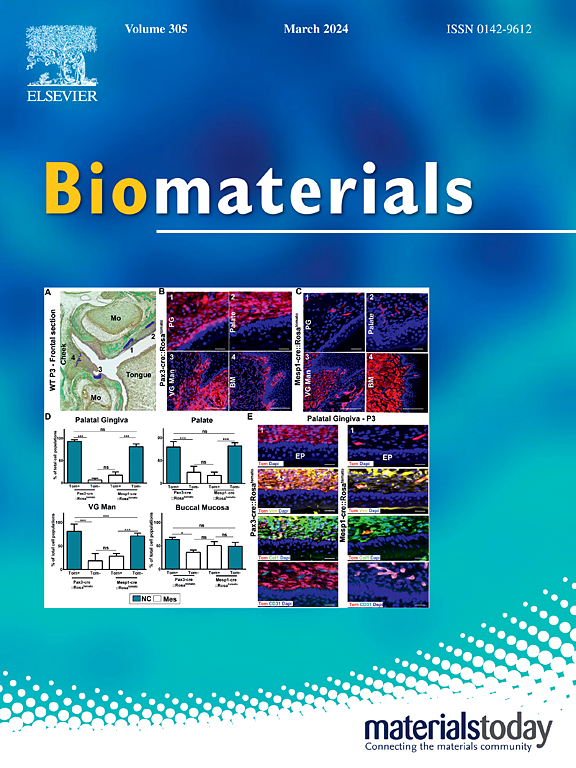Cationic conjugated polymers with tunable hydrophobicity for efficient treatment of multidrug-resistant wound biofilm infections
IF 12.8
1区 医学
Q1 ENGINEERING, BIOMEDICAL
引用次数: 0
Abstract
Biofilm-associated infections arising from antibiotic-resistant bacteria pose a critical challenge to global health. We report the generation of a library of cationic conjugated poly(phenylene ethynylene) (PPE) polymers featuring trimethylammonium terminated sidechains with tunable hydrophobicity. Screening of the library identified an amphiphilic polymer with a C11 hydrophobic spacer as the polymer with the highest antimicrobial efficacy against biofilms in the dark with excellent selectivity. These polymers are highly fluorescent, allowing label-free monitoring of polymer-bacteria/biofilm interactions. The amphiphilic conjugated polymer penetrated the biofilm matrix in vitro and eradicated resident bacteria through membrane disruption. This C11 polymer was likewise effective in an in vivo murine model of antibiotic-resistant wound biofilm infections, clearing >99.9 % of biofilm colonies and efficient alleviation of biofilm-associated inflammation. The results demonstrate the therapeutic potential of the fluorescent conjugated polymer platform as a multi-modal antimicrobial and imaging tool, surpassing conventional antimicrobial strategies against resilient biofilm infection.

具有可调疏水性的阳离子共轭聚合物,用于有效治疗多重耐药伤口生物膜感染。
抗生素耐药细菌引起的生物膜相关感染对全球健康构成重大挑战。我们报道了一个阳离子共轭聚(苯乙烯-乙炔)(PPE)聚合物库的生成,该聚合物具有三甲基胺端链和可调疏水性。文库筛选发现,具有C11疏水间隔的两亲性聚合物对生物膜的抗菌效果最高,具有良好的选择性。这些聚合物是高度荧光的,允许无标记监测聚合物-细菌/生物膜相互作用。两亲性共轭聚合物在体外穿透生物膜基质,并通过破膜去除驻留细菌。这种C11聚合物在耐抗生素伤口生物膜感染的体内小鼠模型中同样有效,清除了99.9%的生物膜菌落,并有效减轻了生物膜相关的炎症。结果表明,荧光共轭聚合物平台作为一种多模态抗菌和成像工具的治疗潜力,超越了针对弹性生物膜感染的传统抗菌策略。
本文章由计算机程序翻译,如有差异,请以英文原文为准。
求助全文
约1分钟内获得全文
求助全文
来源期刊

Biomaterials
工程技术-材料科学:生物材料
CiteScore
26.00
自引率
2.90%
发文量
565
审稿时长
46 days
期刊介绍:
Biomaterials is an international journal covering the science and clinical application of biomaterials. A biomaterial is now defined as a substance that has been engineered to take a form which, alone or as part of a complex system, is used to direct, by control of interactions with components of living systems, the course of any therapeutic or diagnostic procedure. It is the aim of the journal to provide a peer-reviewed forum for the publication of original papers and authoritative review and opinion papers dealing with the most important issues facing the use of biomaterials in clinical practice. The scope of the journal covers the wide range of physical, biological and chemical sciences that underpin the design of biomaterials and the clinical disciplines in which they are used. These sciences include polymer synthesis and characterization, drug and gene vector design, the biology of the host response, immunology and toxicology and self assembly at the nanoscale. Clinical applications include the therapies of medical technology and regenerative medicine in all clinical disciplines, and diagnostic systems that reply on innovative contrast and sensing agents. The journal is relevant to areas such as cancer diagnosis and therapy, implantable devices, drug delivery systems, gene vectors, bionanotechnology and tissue engineering.
 求助内容:
求助内容: 应助结果提醒方式:
应助结果提醒方式:


